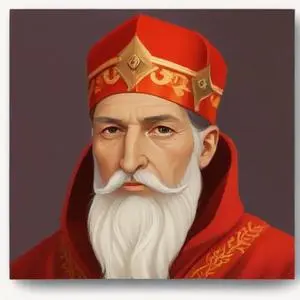
Ruler of Florence who brought stability and prosperity to the city, patronizing artists and humanists, and establishing the Medici dynasty. He was a shrewd politician and banker who laid the groundwork for the Renaissance.
Cosimo de Medici, an Italian banker and politician, is widely regarded as the founder of the Medici dynasty that dominated Florence during the Italian Renaissance. He is known for his unparalleled patronage of the arts, commissioning iconic works such as Donatello's David, the first freestanding nude male sculpture since antiquity, and pouring an astonishing 600,000 gold florins (approximately $500 million in today's currency) into art and culture.
Cosimo de Medici was born on September 27, 1389, in Florence, Italy, to Giovanni di Bicci de Medici and Piccarda Bueri. As a member of the esteemed Medici family, Cosimo was destined for greatness. His father, Giovanni, was a successful banker who had built a thriving business, which Cosimo would later inherit. The Medici family's banking enterprise was so successful that it enabled Cosimo to finance his lavish patronage of the arts.
Cosimo's wealth and influence grew exponentially as he expanded the family's banking business. He cleverly solidified his position by marrying into other powerful families, forging strategic alliances that would secure his family's hold on Florence. His power was not absolute, however, and he was viewed by fellow Florentine politicians as "first among equals" rather than an autocrat. Despite this, Cosimo's influence was undeniable, and he became the de facto ruler of Florence.
Cosimo was a passionate patron of the arts, and his love for beauty and innovation inspired some of the most iconic works of the Renaissance. He commissioned works from renowned artists such as Donatello, Michelozzo, and Fra Angelico, and his generosity funded some of the most groundbreaking projects of the era. His fascination with classical antiquity led to the creation of impressive architectural feats, including the construction of the Palazzo Medici Riccardi.
Cosimo was a humanist at heart, and his love for classical learning and philosophy shaped his worldview. He believed that education and the pursuit of knowledge were essential for the betterment of society. His patronage of scholars and thinkers helped to foster a cultural Renaissance that would spread throughout Europe.
Cosimo's legacy extends far beyond his own lifetime. He is often credited with sparking the Renaissance, a cultural and artistic movement that would transform Europe. His patronage of the arts and his commitment to education paved the way for some of the most influential thinkers and artists of the era. His influence can be seen in the works of Michelangelo, Leonardo da Vinci, and Galileo Galilei, among others.
"States are not governed by laws or by words, but by the character of their rulers."
In conclusion, Cosimo de Medici was a visionary leader who left an indelible mark on history. His patronage of the arts, his commitment to education, and his strategic alliances shaped the course of the Renaissance and inspired some of the most influential minds of the era. His legacy continues to inspire and influence modern society, earning him the title "Godfather of the Renaissance."

Born in 1535
The second shortest-reigning pope in history, serving for just 27 days in 1605, he is most known for his brief but tumultuous papacy marked by power struggles and controversy.
Born in 1469
Italian historian and philosopher who wrote "The Prince", a seminal work on politics and power that still influences modern leadership and governance today.
Born in 1401
The Duke of Milan, a powerful Renaissance leader, expanded his dominion through strategic marriages and military campaigns, fostering a cultural and artistic boom in 15th-century Italy.
Born in 1452
Ruler of Milan who commissioned Leonardo da Vinci's famous painting, The Last Supper, and was a patron of the arts and architecture.
Born in 1423
King of Naples who ruled from 1458 to 1494, known for his military campaigns and cultural achievements, including patronizing artists and writers.